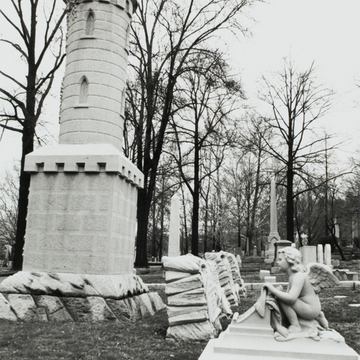Civil engineer James Gilchrist planned Greenwood cemetery, which initially contained thirtyseven and one-half acres, in a romantic style that emphasized curving roadways and extensive landscaping. Now, with its extensive collection of mortuary art and mature plantings in an expanded 100-acre tract, the beautifully maintained cemetery is, with Charleston's Spring Hill ( CH38), the most important example of its genre in the state.
A massive stone Neo-Romanesque gateway arches over the entrance, flanked by a stone gatekeeper's lodge and office. From the entrance, narrow roadways branching in various directions are bordered by an almost bewildering array of funerary art. One unusual granite monument consists of a pedestal supporting four piers that, in turn, support a stone canopy topped by a finial. The words formerly inscribed on the base—“Manufactured by Michael Sweeney—1844”—referred to a 225pound, 4-foot-10–inch cut glass punchbowl, capable of holding twenty-one gallons, which once stood between the piers. Sweeney fabricated three identical bowls in the Sweeney glassworks. He gave one to Henry Clay, sent one in 1851 to London's Great Exhibition (where it won a grand prize), and reserved the third to embellish his monument. After the cemetery bowl became a favorite target for would-be neighborhood hoodlums armed with BB guns, it was taken to the Oglebay Mansion Museum ( WH76.1), where it remains a cherished memento of one of Wheeling's pioneer industries.
Fittingly, the Oglebay family's monument in Greenwood is close to Sweeney's. It is a tall column topped with a Gothic pinnacle that would have done credit to the French gothicist E. E. Viollet-le-Duc. The Schmulbach monument is a single giant-order Corinthian column, carved from granite. The Maxwell family monument is a stone castle, or castle turret. Individual family gravestones surrounding it are designed to replicate sections of stone walls.
Two huge mausoleums form the southeast wall of the cemetery. The mausoleum closest to National Road dates from 1914 and is Egyptian Revival in style. Rows of three-quarter columns with stylized lotus-blossom capitals march along rough stone walls, while two stone sphinxes guard the pylon entrance.

























